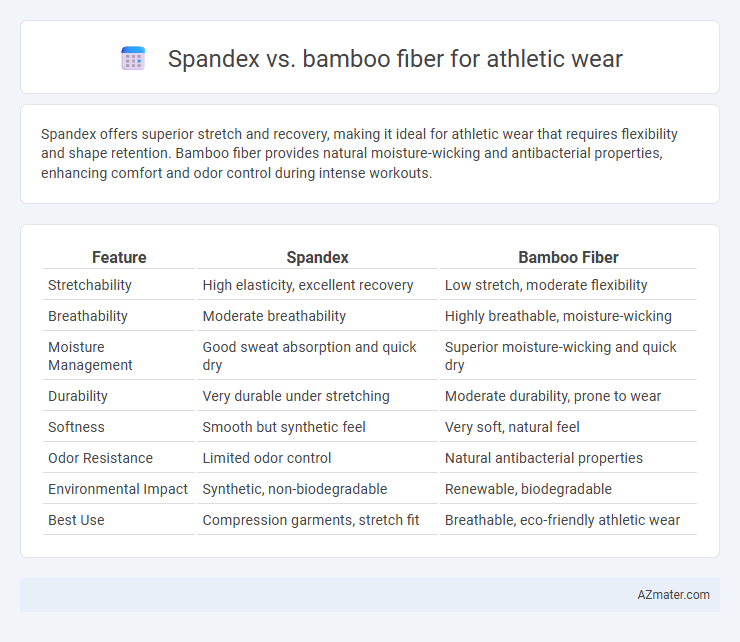Spandex offers superior stretch and recovery, making it ideal for athletic wear that requires flexibility and shape retention. Bamboo fiber provides natural moisture-wicking and antibacterial properties, enhancing comfort and odor control during intense workouts.
Table of Comparison
| Feature | Spandex | Bamboo Fiber |
|---|---|---|
| Stretchability | High elasticity, excellent recovery | Low stretch, moderate flexibility |
| Breathability | Moderate breathability | Highly breathable, moisture-wicking |
| Moisture Management | Good sweat absorption and quick dry | Superior moisture-wicking and quick dry |
| Durability | Very durable under stretching | Moderate durability, prone to wear |
| Softness | Smooth but synthetic feel | Very soft, natural feel |
| Odor Resistance | Limited odor control | Natural antibacterial properties |
| Environmental Impact | Synthetic, non-biodegradable | Renewable, biodegradable |
| Best Use | Compression garments, stretch fit | Breathable, eco-friendly athletic wear |
Introduction to Spandex and Bamboo Fiber
Spandex, a synthetic fiber known for its exceptional elasticity, is widely used in athletic wear for its ability to stretch up to five times its original length while providing enhanced mobility and support. Bamboo fiber, derived from the pulp of bamboo plants, offers natural moisture-wicking, antibacterial properties, and eco-friendly benefits, making it an increasingly popular choice for sustainable athletic apparel. Both materials address key performance needs but differ significantly in origin, breathability, and environmental impact.
Fabric Composition and Manufacturing Process
Spandex is a synthetic fiber known for its exceptional elasticity, often blended with polyester or nylon to enhance stretch and recovery in athletic wear, created through a complex chemical extrusion process. Bamboo fiber, derived from bamboo pulp, undergoes a mechanical or chemical process to transform the natural cellulose into a soft, breathable fabric with inherent moisture-wicking and antibacterial properties. The contrast in manufacturing highlights spandex's engineered resilience versus bamboo's eco-friendly, sustainable origin, impacting fabric performance and environmental footprint in athletic apparel.
Breathability and Moisture-Wicking Properties
Bamboo fiber offers superior breathability compared to spandex, allowing better air circulation that keeps the skin cool during intense workouts. Its natural moisture-wicking properties quickly draw sweat away from the body, enhancing comfort and reducing odor. In contrast, spandex provides excellent stretch and flexibility but has limited breathability and less effective moisture management, often requiring blending with other fibers for optimal athletic performance.
Stretchability and Comfort During Exercise
Spandex offers exceptional stretchability with up to 500% elasticity, providing athletes unrestricted movement and superior recovery after stretching. Bamboo fiber excels in moisture-wicking and breathability, maintaining comfort by regulating body temperature and reducing sweat buildup during intense workouts. Combining spandex with bamboo fiber in athletic wear delivers both flexible support and natural softness, optimizing performance and comfort for active individuals.
Durability and Longevity in Athletic Use
Spandex offers exceptional durability and elasticity, maintaining its shape and resilience through intense workouts and multiple wash cycles, making it a top choice for high-performance athletic wear. Bamboo fiber, while breathable and moisture-wicking, tends to be less durable under rigorous use and may degrade faster when exposed to frequent stretching and washing. Athletic wear blending both materials can balance the durability of spandex with the eco-friendly, antibacterial properties of bamboo fiber, extending garment longevity without sacrificing comfort.
Eco-Friendliness and Sustainability Factors
Bamboo fiber boasts superior eco-friendliness due to its rapid growth, minimal water use, and natural biodegradability, making it a sustainable choice for athletic wear. Spandex, derived from non-renewable petroleum sources and involving energy-intensive manufacturing, has a larger environmental footprint and limited recyclability. Choosing bamboo fiber athletic wear supports reduced carbon emissions and lower chemical pollution, aligning with sustainable fashion goals.
Hypoallergenic and Skin Sensitivity Considerations
Bamboo fiber is naturally hypoallergenic and highly breathable, making it ideal for sensitive skin and reducing irritation during athletic activities. Spandex, though stretchy and form-fitting, can sometimes cause allergic reactions or skin irritation for individuals with sensitivities due to its synthetic nature. Choosing bamboo fiber for athletic wear enhances comfort and skin health by minimizing contact with allergens and promoting moisture-wicking properties.
Performance in Various Athletic Activities
Spandex offers exceptional stretchability and shape retention, making it ideal for high-intensity activities like running and yoga that require flexibility and support. Bamboo fiber provides natural moisture-wicking and breathability, enhancing comfort in low-impact sports such as walking or casual cycling. Performance-wise, spandex excels in durability and compression, whereas bamboo fiber prioritizes temperature regulation and antibacterial properties.
Price Comparison and Affordability
Spandex athletic wear tends to be more affordable due to its widespread production and lower material costs compared to bamboo fiber. Bamboo fiber, though eco-friendly and breathable, typically comes with a higher price tag because of its sustainable processing methods and limited availability. Consumers seeking budget-friendly options usually prefer spandex, while those prioritizing environmental benefits may accept the premium of bamboo fiber.
Conclusion: Which Fiber Suits Your Athletic Needs?
Spandex offers superior stretch and shape retention, ideal for high-intensity workouts requiring maximum flexibility and support. Bamboo fiber excels in moisture-wicking, breathability, and natural antibacterial properties, making it perfect for low-impact activities and those with sensitive skin. Choosing between Spandex and Bamboo fiber depends on your specific athletic demands, balancing performance with comfort.

Infographic: Spandex vs Bamboo fiber for Athletic wear
 azmater.com
azmater.com